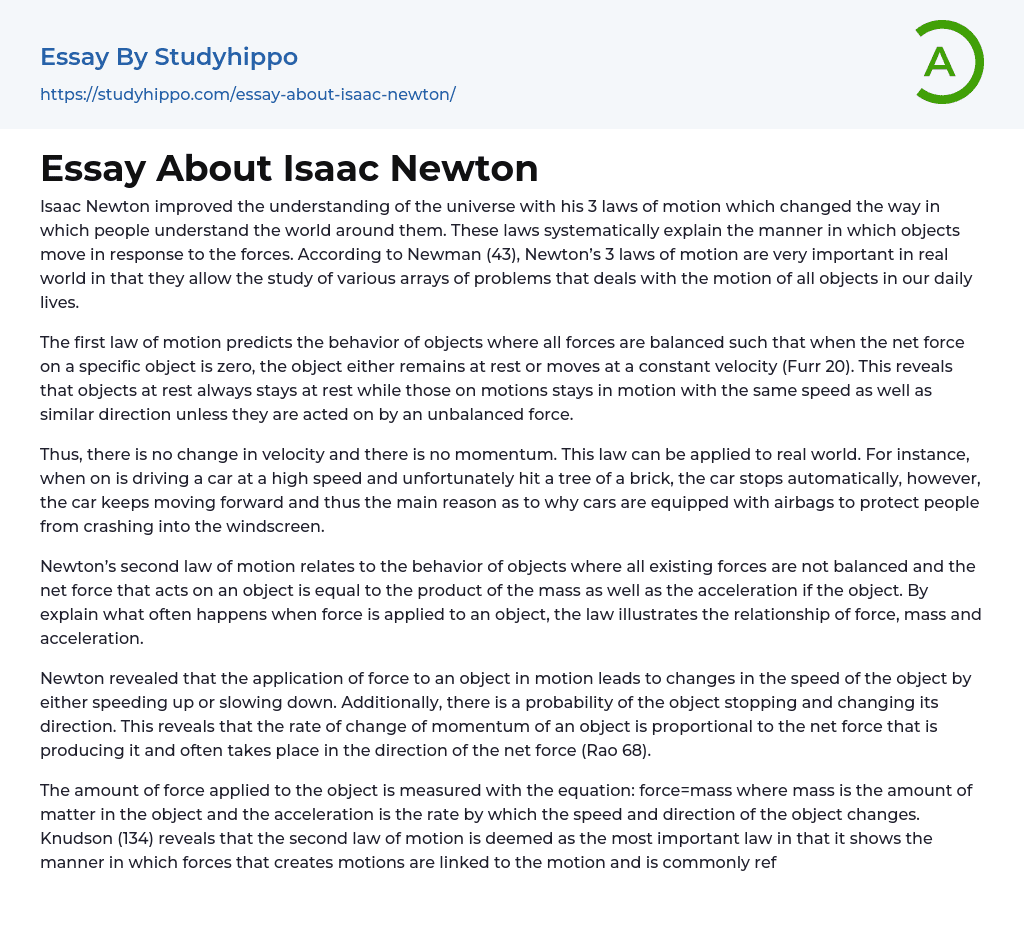Isaac Newton's formulation of three laws of motion completely transformed our comprehension of the universe. These laws brought about a fundamental shift in our perception of the world and its mechanisms. By providing a systematic explanation for how objects respond to forces, Newton's laws have become an essential instrument for analyzing the motion of all objects in our everyday lives (Newman 43). The initial law, in particular, allows us to predict the behavior of objects when all forces are in equilibrium. If the net force acting on an object is zero, it will either remain stationary or continue moving at a constant velocity (Furr 20).
This paragraph explains Newton's first and second laws of motion. The first law states that objects at rest stay still, while moving objects continue to move with the same speed and dire
...ction unless acted upon by an unbalanced force. This means there is no change in velocity or momentum. In practical terms, this can be seen in a high-speed car crashing into a tree or brick – the car stops but still moves forward, which is why airbags are used to protect occupants from hitting the windshield. The second law applies when forces on an object are unbalanced; the net force equals mass multiplied by acceleration.
Newton's law of motion demonstrates the relationship between force, mass, and acceleration by illustrating the impact of applying force to an object. When force is exerted on a moving object, it can either accelerate or decelerate. Additionally, there is a chance that the object may come to a complete halt and change its direction. This indicates that the rate at which an object's momentum changes relie
on the net force applied to it and frequently aligns with the direction of that net force (Rao 68).
The equation force=mass is utilized for measuring the amount of force exerted on an object. The mass of the object indicates the quantity of matter it possesses, while acceleration refers to the rate at which the object's speed and direction change. According to Knudson (134), the second law of motion, also known as the law of momentum or acceleration, is considered highly significant. This law demonstrates how motion-inducing forces are connected to that motion. In practical terms, this law explains why it requires more force to move full shopping carts compared to empty ones since full carts have greater mass. Newton's third law of motion states that when objects interact, their action and reaction forces are always equal in magnitude, opposite in direction, and act on different objects (Lambourne 17).
The law of interaction, also known as Newton's third law of motion, states that objects experiencing interactions will undergo forces. This principle explains that if one object applies a force on another object, the second object will exert an equal and opposite force on the first object. Consequently, every action within the same momentum but with opposing velocity has an equal and opposite reaction. Real-life scenarios such as a balloon rising when air is released exemplify this law.
- Agriculture essays
- Albert einstein essays
- Animals essays
- Archaeology essays
- Bear essays
- Biology essays
- Birds essays
- Butterfly essays
- Cat essays
- Charles Darwin essays
- Chemistry essays
- Dinosaur essays
- Discovery essays
- Dolphin essays
- Elephant essays
- Eli Whitney essays
- Environmental Science essays
- Evolution essays
- Fish essays
- Genetics essays
- Horse essays
- Human Evolution essays
- Isaac Newton essays
- Journal essays
- Linguistics essays
- Lion essays
- Logic essays
- Mars essays
- Methodology essays
- Mineralogy essays
- Monkey essays
- Moon essays
- Mythology essays
- Noam Chomsky essays
- Physics essays
- Plate Tectonics essays
- Progress essays
- Reaction Rate essays
- Roman Numerals essays
- Scientific essays
- Scientific Method essays
- Scientist essays
- Seismology essays
- Space Exploration essays
- Stars essays
- Sun essays
- Thomas Edison essays
- Tiger essays
- Time Travel essays
- Universe essays




